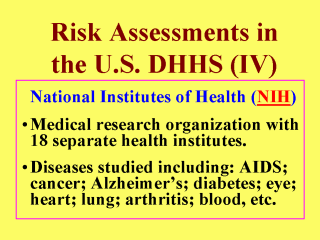| front |1 |2 |3 |4 |5 |6 |7 |8 |9 |10 |11 |12 |13 |14 |15 |16 |17 |18 |19 |20 |21 |22 |23 |24 |25 |review |
 |
The National
Institutes of Health (NIH), another important health agency of the U.S. Department of
Health and Human Services (DHHS), has grown to consist of 18 research institutes whose
missions collectively are to discover new biomedical and behavioral knowledge for use in
the prevention, diagnosis, treatment, and cure of disease and disability. The types of
disease, disability, and services covered by NIH are very broad, including cancer, eye,
heart, lung, blood, aging, arthritis, diabetes, digestive and kidney diseases, allergy,
infectious diseases, child health, human development, dental research, environmental
health, neurological and communicative disorders, general medical sciences, stroke, and
more. Many of the biomedical research findings developed by the NIH institutes ultimately
contribute to health risk assessment (RA) activities. NIH’s National Cancer Institute and National Institute of Environmental Health Sciences continue to be the most committed to quantitative studies relevant to RA. The other NIH institutes have their focus more on identifying and characterizing the causes of disease or disability. Together, their research activities range from basic biochemical investigations conducted in vitro and recombinant DNA to epidemiologic studies and clinical trials in humans. Some of the case studies from NIH that are related to RA include: fat and cancer; fat and heart disease; mammography; analgesic-kidney disease; and cloning-shiga (U.S. DHHS, 1986). |